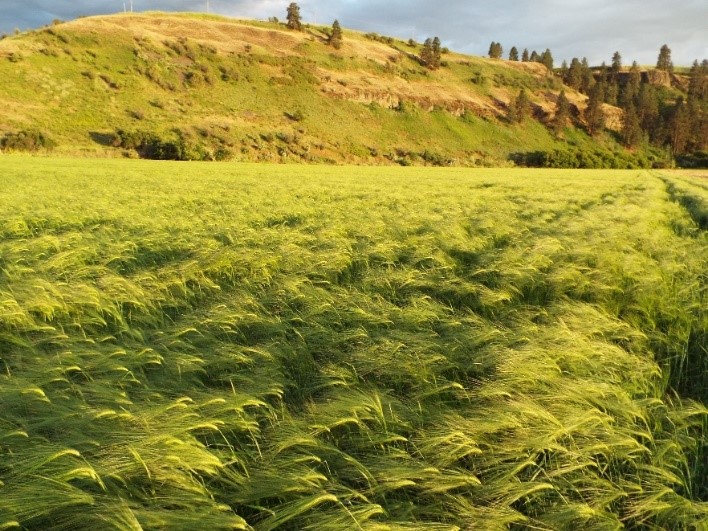This summer brought an opportunity for our extended family to spend several days at Curlew Lake in north central Washington near the town of Republic. Located about twenty miles from the Canadian border, Curlew Lake is magnificent place to fish while enjoying the music of the wind in the towering pines and joyful shouts of young explorers along the shoreline. My son, Karl, and I decided to also investigate the story of Ft. Colvile, the old Hudson’s Bay Company post located near Kettle Falls northwest of Spokane. This area marked the location of the region’s first farms and the historic grist mill that produced the first flour on the upper Columbia. (Note that the present town of Colville, as well as the 19th century military fort of that name, are spelled with two “l’s,” while the old fur trading post preserved the original spelling of namesake Scotsman Andrew Colvile.)
Left: Hudson’s Bay Company “Myers” Mill on the Colville River (looking southeast) near present Kettle Falls, Washington
Same location today (looking southwest)
We learned that Hand-burr (buhr) milling equipment was used to produce the first flour at Ft. Colvile until a water-powered gristmill was built in 1830 several miles south of the fort at Myers Falls on the Colville River. Workers laboriously chiseled a pair of millstones from local granite, and the original stones are now housed at Spokane’s Museum of Arts & Culture. The early mills used two granite grinding stones with canted grooves cut in the rock so grist would be crushed rather than smashed between the stationary nether (bottom) and runner (top). As the runner turned, the grain gradually moved out more finely in the furrows to be thrown out at the edge as flour.
This crude milling required considerable time and produced an oily, starchy germ (which causes flour to become rancid) and whole wheat mixture of protein-rich gluten, fibrous bran, and vitamins. Other products used for “flours” and cereal included brans (outer skins or husks), shorts (bran and germ), and middlings (endosperm and bran). Five bushels of wheat weighing about sixty pounds per bushel typically yielded one 200-pound barrel of flour. Larger areas were soon under cultivation at two nearby company farms that yielded 3,000 bushels of wheat, corn, barley, oats, buckwheat, and peas in 1832. A second, more efficient gristmill was constructed near the original Ft. Colvile structure in the late 1840s and became operational in 1850 to enable substantial distribution of company flour to New Caledonia and the Snake River country.
Rob Smith, Historic Hudson’s Bay Company Flour Mill
Ft. Vancouver’s first grist mill used a small hand-turned stone and was apparently located near the sawmill about 1828. Little of the original fur trading post remains in present Vancouver, Washington, but a magnificent living history recreation and museum are located along the Columbia River in the southwest part of the city. A larger mill at Ft. Vancouver made of locally quarried stone was operating in 1834 but powered by a slow-moving oxen or horses so provided barely enough flour for local needs, though pioneer missionary Samuel Parker considered it “of excellent quality.” Millwright William Crate’s water-powered gristmill was completed in the spring of 1839 on Mill Creek and could grind and bolt about sixty bushels of wheat per day, or 10,000 bushels annually.
Quern (Hand-Burr) Milling
The sonorous sound of rotating stones accompanied by the rhythmic clacking and splashing from the enormous wheel played pleasantly throughout the valley. A visitor to the fort wrote that the mill’s “deep music is heard daily and nightly half the year” in order to process the previous year’s harvest, which also came via wheat bateaux and barges from farms of Willamette Valley settlers. Rev. Parker noted in 1836 that the French Prairie “hunters turned farmers” McLoughlin had charitably aided were producing “first quality” wheat and found a ready market at the fort where it was traded for imported molasses, cocoa, salt, rum, claret, and Chinese tea.
Ft. Vancouver, Ft. Colvile, and Ft. Nez Perces (near present Pasco) soon came to employ a host of voyageurs, farmers, herdsmen, carpenters, blacksmiths, tinsmiths, tailors, and other laborers. They regularly worked from 6 A.M. to 6 P.M. six days a week at these remote outposts where they raised such heritage grains as White Lammas wheat and Scots Bere barley. Ohio native and wagon train leader Lansford Hastings described bustling Ft. Vancouver in the 1840s as a place of “diligent and incessant plying of the hammer, sledges and axes, and the confused toiling and ringing of bells, present all the impetuous commotion, rustling, tumultuous din of a city life, in the oriental world.”
Palouse Colony Farm Scots Bere (July, 2018)





